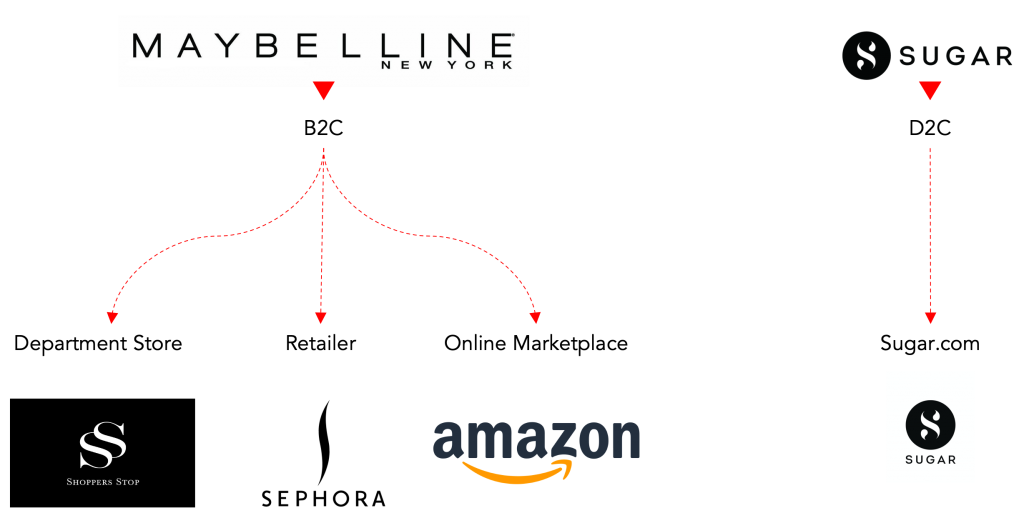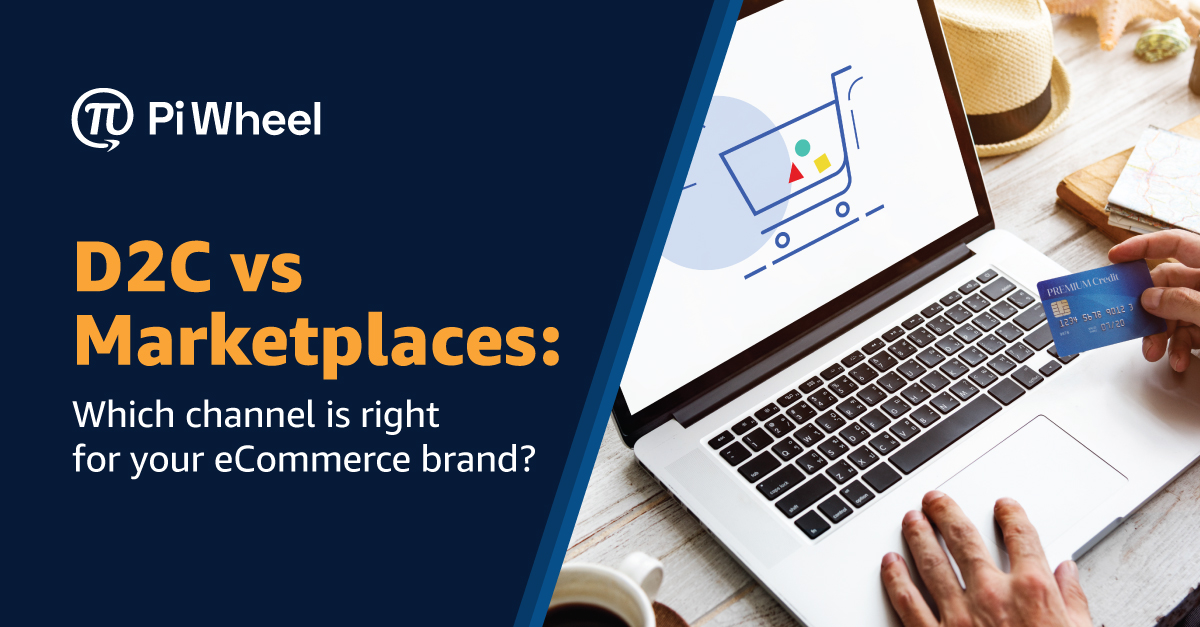You might be living under a rock if you are unaware of the rise of eCommerce. Even before the pandemic, the industry grew rapidly and in the post-pandemic world, it has left a spell on consumers which is hard to pass.
Brands are now focusing on getting to their consumers as fast as possible, with the best channels. Thanks to the internet evolution, they now have multiple channels to reach out to consumers- from marketplaces to social media to their own eCommerce websites.
This article focuses on the 2 major channels of online selling for D2C brands- an eCommerce website or an established marketplace (read Amazon, Noon, Flipkart, etc.). But first, let’s understand what D2C is and what are its benefits of the same.
D2C- what is it and how did it rise to popularity?
D2C is short for direct-to-consumer. In eCommerce, D2C refers to a company that sells its own products directly to the end consumer- without any distributor network or platform.
Earlier, the main categories that were involved in D2C were clothing brands and consumer electronics but now there are 100s of such categories in place, selling directly to consumers.
B2C, on the other hand, involves selling to customers by using a third-party website.
Several famous brands operate in both D2C and B2C spheres.

D2C vs B2C
Let’s look at some of the differences between having your own eCommerce website and placing your product on an online marketplace.
- Definition
Marketplace
ECommerce Website
An online marketplace is a website where a seller (brand or 3P) can list, promote, and sell products against a monthly/quarterly fee and/or takes a cut of the final sale price as part of the retailer margins Some of the popular online marketplaces globally are Amazon, Walmart.com, eBay, Alibaba, etc
An eCommerce website is a brand-owned website (Brand.com), where it can list, promote, and sell products. Most D2C sellers will use an eCommerce platform to create their website and manage marketing, sales, and operations.
- Audience
Marketplace
ECommerce Website
Online marketplaces provide shoppers with variety, low prices, and fast shipping speeds. As a result, they attract massive audience numbers which give your brand potential access to a vast set of audiences, high-performance SEO, and marketplace-loyal customers.
Conversely, an eCommerce website doesn’t have the privilege of pre-existing traffic & It’s on the brand, to reach out to customers, advertise the products, and optimize your keywords to build your own segment of the audience. It allows the brand total control over the type of traffic you want to have on your website and how you attract them.
- Cost of selling
Marketplace
ECommerce Website
Many marketplaces charge referral fees as a commission against a sale on their platform, driving up your cost of acquisition and it can get expensive with the more volume you sell. On leading marketplaces such as Walmart, Amazon, etc, these charges are usually a combination of a monthly fee and percentage of sales based on category.
There are no marketplace fees when selling on your own website, however, there are other expenses that come with running your own websites such as website maintenance & development, platform fees depending on whether you use Shopify or BigCommerce, and payment transaction fees.
- Retention
Marketplace
ECommerce Website
Marketplaces have respective guidelines in place against soliciting emails or asking shoppers to visit external websites as well as enabling to group similar items together to help shoppers find the best price, delivery date, etc. This can be a challenge at times, as it’s difficult to leave an impression, as the goal of the marketplace is to make a sale irrespective of the brand
Winning on conversion on your D2C website can make your brand presence felt more prominently than on a marketplace, where your brand may well get lost among thousands of other competing products offering the same deal or faster shipping. Brands can also offer incentives to register for an account or sign up for a newsletter to give themselves a direct line to reach the shoppers.
- Barriers to entry
Marketplace
ECommerce Website
Online marketplaces require stringent entry norms to be met by brands before registering on the platform, ranging from having a registered business and competitively priced products to demonstrating significant expertise as well as online selling experience
Any brand can set up an eCommerce website of their own provided they carry the necessary technical or marketing abilities to design a website and attract customers.
- Seller tools
Marketplace
ECommerce Website
Online marketplaces provide various toolkits to help brands accelerate their business by leveraging the data from real-time shoppers and capitalize on micro-marketing opportunities such as Product research tools, Sales reports, Marketplace ads, etc
Few eCommerce websites provide the business analytics tools to strengthen your D2C business such as Built-in tools, such as Shopify KIT management, Third-party apps, such as repricing tools, product recommendation plug-ins, and live chat.
- Sustainability
Marketplace
ECommerce Website
Online marketplace stores are essentially a more business-friendly model with speed to launch, allowing easy traction for your D2C business. However, the brand may cease to be independent of the external macro-environment including marketplace rules and other sellers. You may have limited control over your brand and the customer experience, and you have thousands of other sellers to compete against, making it difficult to scale up your business
eCommerce platforms are probably more effort-intensive to launch & require the brand to put effort into designing the brand store, creating brand awareness, and attracting customers. After passing the initial phase, a brand can have absolute control over growing the business, creating customer experiences and driving customer loyalty & thereby making it easy to scale up.
D2C: The goods & the bad
Benefits:
- Incremental Profits
The single biggest reason why D2C brands see larger profit margins than other online sellers is that there is no middleman to eat a pie of their retail price. And it’s because of these higher profits, that many D2C brands can afford to price their products cheaper on their own channels than other retailers. - Tailormade Customer Experience
With the rich data on their customers otherwise unavailable while selling through a retailer, D2C sellers can build a super-personalized experience for their customers—it becomes all the more crucial, as 80% of shoppers would instead purchase from brands that offer a higher degree of personalization. - Higher brand loyalty
As selling directly to the consumer gives brands an upper hand in terms of building customer loyalty as opposed to in wholesale marketplaces, D2C sellers can further capitalize on brand loyalty
Pitfalls:
- Everything falls on your shoulders
Since you are the one handling everything from marketing to sales to distribution, all the liabilities need to be tackled at your end. Some situations that you need to take care of include shipping time and costs, cyber security. - Differentiating factor
Let’s face it if your D2C website doesn’t offer a differentiating factor against the competitor websites or marketplaces, then it will be a problem in the long run since you might struggle to get enough exposure to your products. - Search engine and social media
Your SEO game needs to be on point when it comes to your own website. It’s a jungle out there and with so many growing brands, it can be easy to get lost.
Over 60% of online product searches start with Amazon so any aspiring D2C brand needs to be mindful of the eCommerce marketplaces if they want to grow forward.
Which is best for your D2C store?
The choice to be made by the brand as to which route between marketplace & website is the best for your D2C business, the fundamental criteria for which is the very purpose & vision the brand has for the business. The marketplace is a suitable choice if you want to reach a broad audience and create early traction under another brand’s name.
However, if the objective is to build an independent brand by curating your audience and setting yourself up for long-term success, websites are the go-to option.
You can also find a blended approach with both your website and marketplace selling. Testing is crucial for that. Start out with a category if not your entire portfolio and see how the consumers are reacting to your products, and whether the sales are making up for the seller fees.
Unlocking the potential of your brand requires testing and the willingness to let data drive decision-making. If you need help with marketplace data and services, we are here for you to chalk out the entire strategy with market intelligence data.
Feel free to download and share this blog infographic:




